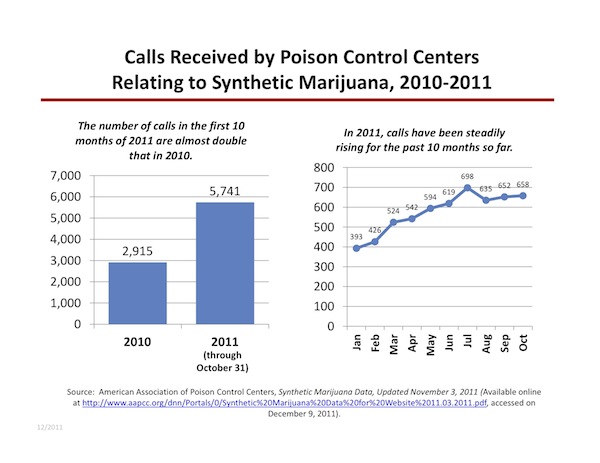
Today, the National Institute on Drug Abuse released the 2011 Monitoring the Future survey, which included some troubling new information on the prevalence of synthetic drug use among high school seniors. The results indicate that one in nine high school seniors had used “Spice” or “K2” over the past year. That means synthetic marijuana is now the second most frequently used illicit drug, after marijuana, among high school seniors.
So what do we know about these synthetic drugs?
First, they’re dangerous. Poison Control Centers operating across the Nation have reported over 5,500 calls relating to synthetic marijuana as of October 31 of this year. That’s almost double the number received in all of 2010. We also know that state and local public health departments note that these drugs cause serious adverse health effects, including agitation, anxiety, nausea, vomiting, tachycardia (fast, racing heartbeat), elevated blood pressure, tremor, seizures, hallucinations, and paranoid behavior.

Making matters worse, these drugs are often marketed as “legal” substances. They are sometimes labeled as “herbal incense” and sold in small pouches or packets over the Internet, in tobacco and smoke shops, drug paraphernalia shops, gas stations, and convenience stores.
There’s still a lot we do not know about these drugs, but here’s what we do know: We must all work together to respond to this emerging threat. The good news is that over the past year, the Federal Government has taken comprehensive action to address this challenge:
- ONDCP has convened several working group meetings to bring public health and safety agencies from across the Federal Government together to share data and coordinate the Federal response to reduce the threat these drugs pose.
- In March, the Drug Enforcement Administration used its emergency scheduling authority to ban the sale of the chemicals used to manufacture K2 and Spice.
- We are also working with Congress to pass new laws aimed at reducing the availability of these drugs. Just last week, the House of Representatives passed legislation that would ban synthetic drugs, including those marketed as “bath salts.” (And at least 38 states have taken action to ban the chemicals found in K2 and Spice, as well.)
- Over the next few weeks, ONDCP will reach out to a nationwide network of public health and safety organizations to provide them with the latest information we have on this public health problem, raise awareness, and spur action at the local level.
We will continue to address this threat. But parents, too, must take action. Parents are the most powerful force in the lives of their teens. That is why we ask that all of you take time today to talk to your teens about the serious consequences of using marijuana – in whatever form it may come, including synthetic forms like K2 and Spice.
Additional Resources:
- 2011 Monitoring the Future Survey Highlights
- Synthetic Marijuana fact sheet
- National institute on Drug Abuse press release
- Monitoring the Future survey findings
Rafael Lemaitre is Associate Director for Public Affairs

